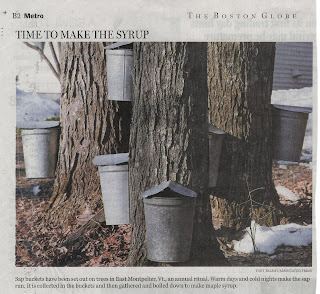 Early spring in New England means one important, coveted crop is harvested: maple sap. This humble ingredient is harvested and transformed into syrup when the weather is the perfect combination of cool nights and warm days, when the sugar is high, and when the sap has started to run. Our Boston and Somerville papers were full of references to the syrup season, from major operations in Vermont, to the Somerville Community Garden production, and even backyard producers here in Massachusetts.
Early spring in New England means one important, coveted crop is harvested: maple sap. This humble ingredient is harvested and transformed into syrup when the weather is the perfect combination of cool nights and warm days, when the sugar is high, and when the sap has started to run. Our Boston and Somerville papers were full of references to the syrup season, from major operations in Vermont, to the Somerville Community Garden production, and even backyard producers here in Massachusetts. Many people in this region continue to use horses to pull the pallets of buckets out of the woods, and the technology needed for reducing the sap to syrup is surprisingly simple: the sap is boiled until enough water has evaporated to leave behind the amber liquid. The sap flows but once a year, and the harvest and production is labor intensive, making this product very expensive - but worth every penny.
Many people in this region continue to use horses to pull the pallets of buckets out of the woods, and the technology needed for reducing the sap to syrup is surprisingly simple: the sap is boiled until enough water has evaporated to leave behind the amber liquid. The sap flows but once a year, and the harvest and production is labor intensive, making this product very expensive - but worth every penny. Andrew has dreamed of having his own maple syrup production, and we visited a producer in Vermont last spring where we learned that the University of Vermont has a maple research center! The Proctor Maple Research Center focuses its research on the sugar maple, and they have the forest, sugarhouse, and labs to study this tree and syrup production - they even have a webcam focused on the sugarhouse ("Sugarhouse Cam") during the syrup-making season so we can follow their progress. While the winter may feel very barren and bleak in the darkest days, there are constant surprises and food wonders!

No comments:
Post a Comment